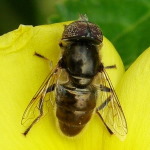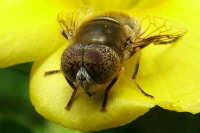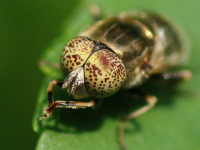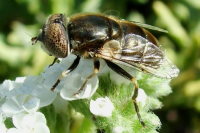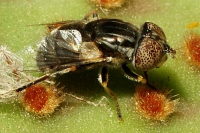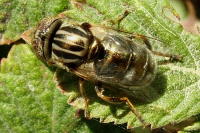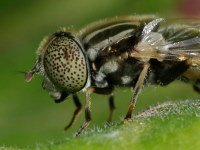Phylum Arthropoda (Arthropods) ➔ Subphylum Hexapoda (Hexapods) ➔ Class Insecta (Insects) ➔ Order Diptera (True flies) ➔ Family Syrphidae (Hoverflies)
Eristalinus (Lathyropthalmus) aeneus (Scopoli, 1763)
Glänzende Faulschlammschwebfliege Larger Spotty-eyed Drone Fly
Synonyms and other combinations:
Conops stygius Newman, 1835 | Eristalis aenescens Macquart, 1842 | Eristalis concolor Philippi, 1865 | Eristalis cuprovittatus Wiedemann, 1830 | Eristalis sincerus Harris, 1841 | Eristalis sincerus Walker, 1849 | Eristalis taphicus Wiedemann, 1830 | Lathyrophthalmus nigrolineatus Herve-Bazin, 1923 | Musca leucocephala Gmelin, 1790 | Musca macrophthalma Preyssler, 1791 | Musca ochroleuca Gmelin, 1790 | Musca punctata Müller, 1764 | Syrphus aeneus Fabricius, 1794 | Syrphus auricalcicus Rondani, 1865 |
Classification:
Eristalinus aeneus belongs to the subfamily Eristalinae, tribe Eristalini.Distribution:
Cosmopolitan; southern Sweden south to North Africa and the Canary Isles; on into the Afrotropical region south to Kenya and Tanzania; from Ireland eastwards through central and southern Europe and on through Russia and China to the Pacific and south into the Oriental region; Mauritius; in North America from Minnesota and Ontario south to California and Texas; Hawaii, Australia and the Gilbert and Ellis islands in Australasia; Bermuda.Habitat:
Near fresh water (coastal areas, ponds, rivers and irrigation ditches), in continental Europe also at greater distance to the water.Description:
The 9 - 12 mm long Eristalinus aeneus has a shiny metallic brown abdomen and a glossy brown-black monochrome or brightly striped thorax. Hind femora and hind tibiae are only slightly curved. The knees are yellow. The strikingly patterned eyes have dark spots on a light background. In the males the eyes are touching.A similar species is Eristalinus sepulchralis, which has curved hind femora and hind tibiae. In the males of Eristalinus sepulchralis the eyes are separated.
Biology:
Eristalinus aeneus flies from April to Oktober. Adults are flower visitors. The species overwinters as an adult.Outside of Europe in the Canary Islands, the species probably flies all year round. In Fuerteventura, I observed Eristalinus aeneus flying in February, March and December.
The larvae of Eristalinus aeneus live in shallow water with decomposing organic matter. They are of the 'rat-tailed' aquatic type. The so-called rat tail at the back end of the larva is a breathing tube that allows the larva to breathe under water.
References, further reading, links:
- Pape T. & Thompson F.C. (eds) (2017). Systema Dipterorum (version 2.0, Jan 2011). In: Species 2000 & ITIS Catalogue of Life, 2017 Annual Checklist (Roskov Y., Abucay L., Orrell T., Nicolson D., Bailly N., Kirk P.M., Bourgoin T., DeWalt R.E., Decock W., De Wever A., Nieukerken E. van, Zarucchi J., Penev L., eds.). Digital resource at www.catalogueoflife.org/annual-checklist/2017. Species 2000: Naturalis, Leiden, the Netherlands. ISSN 2405-884X.
- M.C.D.Speight: Species Accounts of European Syrphidae (Diptera), Glasgow 2011, Syrph the Net, the database of European Syrphidae, vol. 65, 285 pp., Syrph the Net publications, Dublin.
- Gerald Bothe: Bestimmungsschlüssel für die Schwebfliegen (Diptera, Syrphidae) Deutschlands und der Niederlande, DJN, 1984, ISBN 3-923376-07-3
- Menno Reemer, Willem Renema, Wouter van Steenis, Theo Zeegers, Aat Barendregt, John T. Smit, Mark P. van Veen, Jeroen van Steenis, Laurens van der Leij: De Nederlandse Zweefvliegen (Diptera: Syrphidae), Nederlandse Fauna 8, 2009.
- Anasimyia interpuncta
- Anasimyia transfuga
- Baccha elongata
- Brachyopa sp.
- Brachypalpoides lentus
- Brachypalpus laphriformis
- Brachypalpus sp.
- Brachypalpus valgus
- Ceriana conopsoides
- Ceriana vespiformis
- Chalcosyrphus femoratus
- Chalcosyrphus valgus
- Cheilosia albipila
- Cheilosia albitarsis
- Cheilosia chrysocoma
- Cheilosia illustrata
- Cheilosia pagana
- Cheilosia scutellata
- Cheilosia sp.
- Chrysogaster sp.
- Chrysotoxum bicinctum
- Chrysotoxum fasciatum
- Chrysotoxum festivum
- Chrysotoxum verralli
- Criorhina berberina
- Dasysyrphus albostriatus
- Dasysyrphus sp.
- Dasysyrphus tricinctus
- Didea fasciata
- Didea intermedia
- Didea sp.
- Epistrophe diaphana
- Epistrophe eligans
- Epistrophe flava
- Epistrophe melanostoma
- Epistrophe melanostoma/nitidicollis
- Epistrophella euchroma
- Eristalinus megacephalus
- Eristalis interrupta
- Eristalis intricaria
- Eristalis lineata
- Eristalis rupium
- Eristalis similis
- Eristalis sp.
- Eumerus purpurariae
- Eumerus sp.
- Eupeodes luniger
- Eupeodes sp.
- Ferdinandea cuprea
- Helophilus hybridus
- Helophilus sp.
- Helophilus trivittatus
- Ischiodon aegyptius
- Leucozona glaucia
- Leucozona laternaria
- Leucozona lucorum
- Melangyna lasiophthalma
- Melangyna quadrimaculata
- Melangyna umbellatarum
- Melanogaster sp.
- Meligramma triangulifera
- Meliscaeva cinctella
- Merodon ambiguus
- Merodon avidus
- Merodon moenium
- Merodon obscuritarsis
- Merodon sp.
- Microdon analis/major
- Microdon mutabilis/myrmicae
- Myolepta dubia
- Orthonevra sp.
- Paragus sp.
- Parasyrphus lineolus
- Parhelophilus sp.
- Pipiza austriaca
- Pipiza bimaculata
- Pipiza fenestrata
- Pipiza sp.
- Platycheirus rosarum
- Platycheirus sp.
- Rhingia rostrata
- Scaeva albomaculata
- Scaeva selenitica
- Sericomyia lappona
- Sphaerophoria rueppelli
- Sphaerophoria sp.
- Sphegina sp.
- Spilomyia saltuum
- Syrphus sp.
- Syrphus vitripennis
- Temnostoma bombylans
- Temnostoma meridionale
- Temnostoma vespiforme
- Tropidia scita
- Xanthogramma citrofasciatum
- Xanthogramma pedissequum
- Xylota sp.
- Xylota sylvarum
- Aspen Hoverfly
- Band-eyed Drone Fly
- Black-horned Smoothtail
- Brown-toed Forest Fly
- Bumblebee Hoverfly
- Chequered Hoverfly
- Common Bog Hoverfly
- Common Drone Fly
- Common Snout-hoverfly
- Deadhead Hover Fly
- Dusky-banded Forest Fly
- European Drone Fly
- Figwort Cheilosia
- Four-spotted Pipiza
- Hornet Mimic Hoverfly
- Large Hoverfly
- Large Narcissus Fly
- Larger Spotty-eyed Drone Fly
- Long Hoverfly
- Marmalade Fly
- Migrant Hoverfly
- Orange-belted Plumehorn
- Pied Hoverfly
- Pine Hoverfly
- Snouted Duckfly
- Summer Fly
- Sun Fly
- Tapered Drone Fly
- Thick legged Hoverfly
- White-banded Drone Fly
